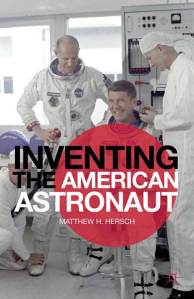So many books have been written by and about astronauts that it doesn’t seem like there is much left to cover. Yet Matthew H. Hersch breaks new ground in Inventing the American Astronaut (Palgrave Macmillian, 2012) by examining the evolution of the astronaut as a professional class. Space history, as Asif Saddiqi points out in “American Space History: Legacies, Questions, and Opportunities for Further Research,” too easily falls into a number of familiar plot lines — the hero quest, the Cold War race, the triumph of American technology, or the restless spirit of human exploration — all of which drive professional historians completely crazy. Why? Because these plot lines often dictate the direction of the narrative rather than the details of the subject itself.
Hersch doesn’t fall into this trap. The creation of the astronaut corp, he makes clear, could have unfolded differently. Early NASA administrators thought that test pilots — comfortable with technology, accepting of risk, and rigorous in their shakedowns of new planes — would make the best candidates for spaceflight. Once these test pilots entered the astronaut corps, flying the missions of the Mercury Program, they gained authority as popular heroes, influenced the design of spacecraft, and entered the NASA ranks as senior pilots and administrators. Thus established, the test-pilot astronaut became the benchmark by which future candidates were measured. Space scientists, by contrast, were generally ranked lower than test pilots and waited longer for flight assignments. While NASA’s 1958 charter put a priority on “the expansion of human knowledge of the Earth and of phenomena in the atmosphere and space” science was of secondary importance on Mercury, Gemini, and Apollo missions. Moreover, the narrow demographics of military test pilots — almost all of whom were white and male — became the demographic of the NASA astronaut as well. Only in the 1970s and 1980s would this begin to change as women, minorities, and non-test pilot astronauts entered the ranks with the Space Shuttle.
Behind the scenes, astronauts endured hardships that extended beyond the risks of spaceflight. The selection process was highly competitive, but also mysterious. It was unclear which skills — physical, intellectual, interpersonal, or psychological — were most important for obtaining a mission assignment. Once astronauts flew in space, their public and professional cache increased dramatically — as well as their opportunities for future missions. Rookie astronauts, by contrast, lived more precariously — never knowing for certain whether or not they would receive a flight assignment. So while the public viewed astronauts as cool-headed professionals, the reality was less inspiring. The Astronaut Office,wrote NASA engineer Homer Hickam, was producing “bureaucratic combatants with warped personalities” (162).
If this sounds like more like Dilbert than Deep Space 9 it is because Hersch has a larger point, one that he makes convincingly: the astronaut represented a late 20th century professional class, one that demonstrated many similarities to earlier 20th century professionals, particularly middle-class engineers. Even at 25,000 mph, these rocket men could not escape the gravitational pull of the workplace, a force that shaped the arc of their careers from Johnson Space Center to the Sea of Tranquility.













Leave a comment